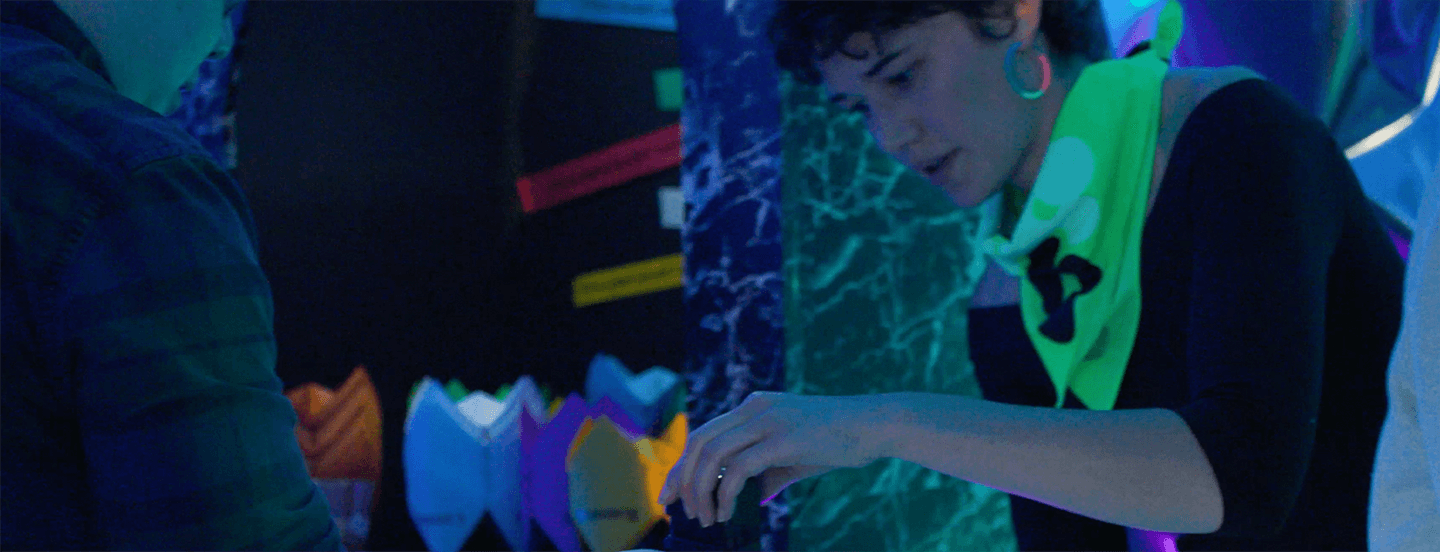
The Room of Paradox of Choice: The Easiest Choice is None
In our world of endless choices, how receptive are we to having an AI assistant make both difficult and mundane decisions for us?
At this year’s SXSW Festival, frog explored this question and others in a series of on-site “provocation rooms.” Each room focused on the power of provocation to stimulate thought.
AI Engagement: Fortune Tellers and Avatars
As AI is rapidly taking center stage in our society, The Room of Paradox of Choice explored a fundamental concern: how people will interact with AI and what feels comfortable to them.
Using the Choice Maker AI bot that was specifically developed for the event, guests could make decisions in several ways. One way was via voice only—purely conversational. Think talking to an Alexa device. To achieve this, the team housed the voice agent within an eyeball sculpture as a way for users to interact with AI. A second means of interaction was via a video “alien” avatar that relayed questions to the AI bot.
People also used a third, analog method to engage with generative AI in the form of themed paper fortune tellers that had AI-generated answers to various questions. This method contrasted with the incredible power of conversational AI experiences. But all three methods helped people make decisions.
Already, we are getting used to allowing AI to make some decisions for us:
- Prepared meal kits
- Automated content recommendations
- Digital or online personal trainers
- GPS directions
- “I’m feeling lucky” search results
Many people respond positively to an outside entity making choices for them, but not everyone. Some want the ability to choose, even though each day can bring copious amounts of decisions. “We wanted to test the limits of what people might allow an AI assistant to decide for them and to learn how introducing conversational and visual interfaces might add emotional depth to the experience,” said Ryan Flynn, Principal Director at frog.
Conversing with AI: Avatar or Anonymity?
Do people ask different questions when speaking to a human avatar versus when speaking to a computer? How does the conversation differ, and which answers do they find more helpful? Though people enjoyed both interactive AI experiences—the video alien avatar and the eyeball bot—they responded differently to both. Overall, people tended to spend more time with the conversational eyeball bot than with the alien avatar.
This was partly because they were uncertain if there was a human behind the video alien avatar (which there was). This person conversed with the participants, utilizing the AI Choice Maker bot to provide the response. In an attempt to replicate the conversational experience, the human simply read whatever response the Choice Maker bot supplied. Since many assumed there was a human behind it, their actions were tempered by conversational norms.
The only difference between this interaction and the eyeball bot interaction was the addition of a video interface to converse with. People were more playful with the eyeball bot because they felt complete anonymity, so they were unconcerned about expending someone’s time, trying someone’s patience or exposing themselves to scrutiny. Hence, they felt free to ask the same question in six different ways just to see what the response would be. They could ask, how do I bury a body? “Obviously, they weren’t serious, but they were free to push the limits without judgment,” Ryan notes. “Kind of cool.”
The frog team was surprised because they expected that having a human (in the form of a video alien avatar) as the medium of delivery would actually increase trust with humans being more familiar or more trustworthy. But this exercise demonstrated otherwise.
Autonomy: How Important Is It?
The happenings in The Room of Paradox of Choice raised the issue of autonomy. In particular, what autonomy are we willing to sacrifice for convenience? What decisions would we relinquish to an AI bot if it could execute our commands?
AI doesn’t only show up digitally. “We observed that many who used the paper fortune tellers felt certain that AI couldn’t have been behind the answers. When we explained that everything was AI-generated, people insisted this was not the case. We were amused that they were so confident about this. But we had to let them know that AI-generated answers can be on paper. It’s noteworthy because AI can still be controlling the conversation, even after being printed out,” said frog alum Marissa Klein.
AI technology is here, and there are countless ways AI and voice technology will increase our efficiency and cut out repetitive tasks and help us make choices. Is it time to embrace AI personally and professionally as a decision-making partner?
From a business perspective, The Room of Paradox of Choice highlighted how questions and engagement differs between the two experiences and how that might inform how brands can engage their users. At frog, we’ve built the partnerships and expertise to find the right technology to fit your solution and the right strategy to implement voice-enabled AI tools for your customers. Connect with us to discuss your needs.
This was the third in a series of five blog posts that explore the power of provocation, inspired by frog’s presence at SXSW 2023. Check out the first article in the provocation room series, The Room of Nothing, where we’re urged to quiet our minds and bring brilliance and The Room of Urgency where we learned to embrace the ephemeral. Please drop by again to learn about how provocations can inspire and shape the creative process. Take a peek into the electrifying atmosphere within frog’s innovative provocation spaces in a short video below.

 Play video
Play videoAuthors
Ryan Flynn, Principal Director, frog
Marissa Klein, frog alum
Briana Mazzio, Senior Interaction Designer, frog

With over 20 years in the industry, Ryan is a highly experienced and innovative digital product designer known for creating pioneering apps and services. He heads Interaction Design at frog East, bringing a dynamic energy, supportive leadership style and meticulous attention to detail to his role. Ryan’s specialty is transforming complex concepts into intuitive, user-friendly designs that are universally accessible.
His expertise in digital platforms extends across multiple sectors, including AI, finance, healthcare, personal data, insurance and e-commerce. Ever driven by his passion for design, Ryan stays ahead of the curve by exploring emerging technologies such as AI, ambient computing, no-UI and voice-controlled systems. He leaves a transformative impact on the digital landscape through every project.

frog, part of Capgemini Invent is a global design and innovation firm. We transform businesses at scale by creating systems of brand, product and service that deliver a distinctly better experience. We strive to touch hearts and move markets. Our passion is to transform ideas into realities. We partner with clients to anticipate the future, evolve organizations and advance the human experience.
We respect your privacy
We use Cookies to improve your experience on our website. They help us to improve site performance, present you relevant advertising and enable you to share content in social media. You may accept all Cookies, or choose to manage them individually. You can change your settings at any time by clicking Cookie Settings available in the footer of every page. For more information related to the Cookies, please visit our Cookie Policy.